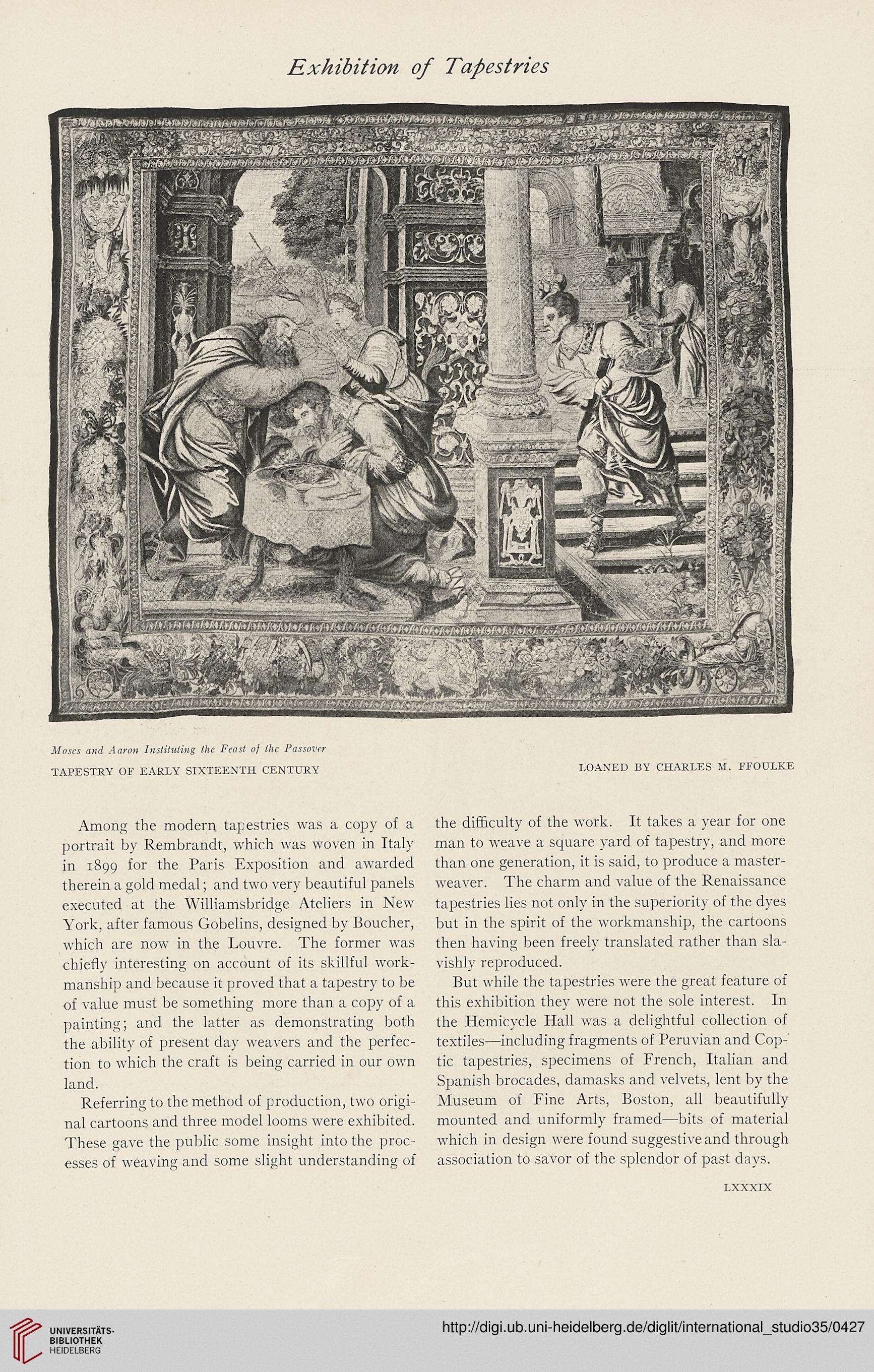Exhibition of Tapestries
Moses and Aaron Instituting the Feast of the Passover
TAPESTRY OF EARLY SIXTEENTH CENTURY LOANED BY CHARLES M. FFOULKE
Among the modern tapestries was a copy of a
portrait by Rembrandt, which was woven in Italy
in 1899 for the Paris Exposition and awarded
therein a gold medal; and two very beautiful panels
executed at the Williamsbridge Ateliers in New
York, after famous Gobelins, designed by Boucher,
which are now in the Louvre. The former was
chiefly interesting on account of its skillful work-
manship and because it proved that a tapestry to be
of value must be something more than a copy of a
painting; and the latter as demonstrating both
the ability of present day weavers and the perfec-
tion to which the craft is being carried in our own
land.
Referring to the method of production, two origi-
nal cartoons and three model looms were exhibited.
These gave the public some insight into the proc-
esses of weaving and some slight understanding of
the difficulty of the work. It takes a year for one
man to weave a square yard of tapestry, and more
than one generation, it is said, to produce a master-
weaver. The charm and value of the Renaissance
tapestries lies not only in the superiority of the dyes
but in the spirit of the workmanship, the cartoons
then having been freely translated rather than sla-
vishly reproduced.
But while the tapestries were the great feature of
this exhibition they were not the sole interest. In
the Hemicycle Hall was a delightful collection of
textiles—including fragments of Peruvian and Cop-
tic tapestries, specimens of French, Italian and
Spanish brocades, damasks and velvets, lent by the
Museum of Fine Arts, Boston, all beautifully
mounted and uniformly framed—bits of material
which in design were found suggestive and through
association to savor of the splendor of past days.
LXXXIX
Moses and Aaron Instituting the Feast of the Passover
TAPESTRY OF EARLY SIXTEENTH CENTURY LOANED BY CHARLES M. FFOULKE
Among the modern tapestries was a copy of a
portrait by Rembrandt, which was woven in Italy
in 1899 for the Paris Exposition and awarded
therein a gold medal; and two very beautiful panels
executed at the Williamsbridge Ateliers in New
York, after famous Gobelins, designed by Boucher,
which are now in the Louvre. The former was
chiefly interesting on account of its skillful work-
manship and because it proved that a tapestry to be
of value must be something more than a copy of a
painting; and the latter as demonstrating both
the ability of present day weavers and the perfec-
tion to which the craft is being carried in our own
land.
Referring to the method of production, two origi-
nal cartoons and three model looms were exhibited.
These gave the public some insight into the proc-
esses of weaving and some slight understanding of
the difficulty of the work. It takes a year for one
man to weave a square yard of tapestry, and more
than one generation, it is said, to produce a master-
weaver. The charm and value of the Renaissance
tapestries lies not only in the superiority of the dyes
but in the spirit of the workmanship, the cartoons
then having been freely translated rather than sla-
vishly reproduced.
But while the tapestries were the great feature of
this exhibition they were not the sole interest. In
the Hemicycle Hall was a delightful collection of
textiles—including fragments of Peruvian and Cop-
tic tapestries, specimens of French, Italian and
Spanish brocades, damasks and velvets, lent by the
Museum of Fine Arts, Boston, all beautifully
mounted and uniformly framed—bits of material
which in design were found suggestive and through
association to savor of the splendor of past days.
LXXXIX




